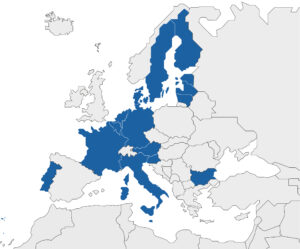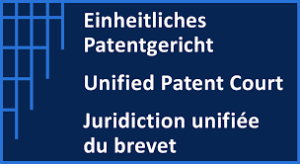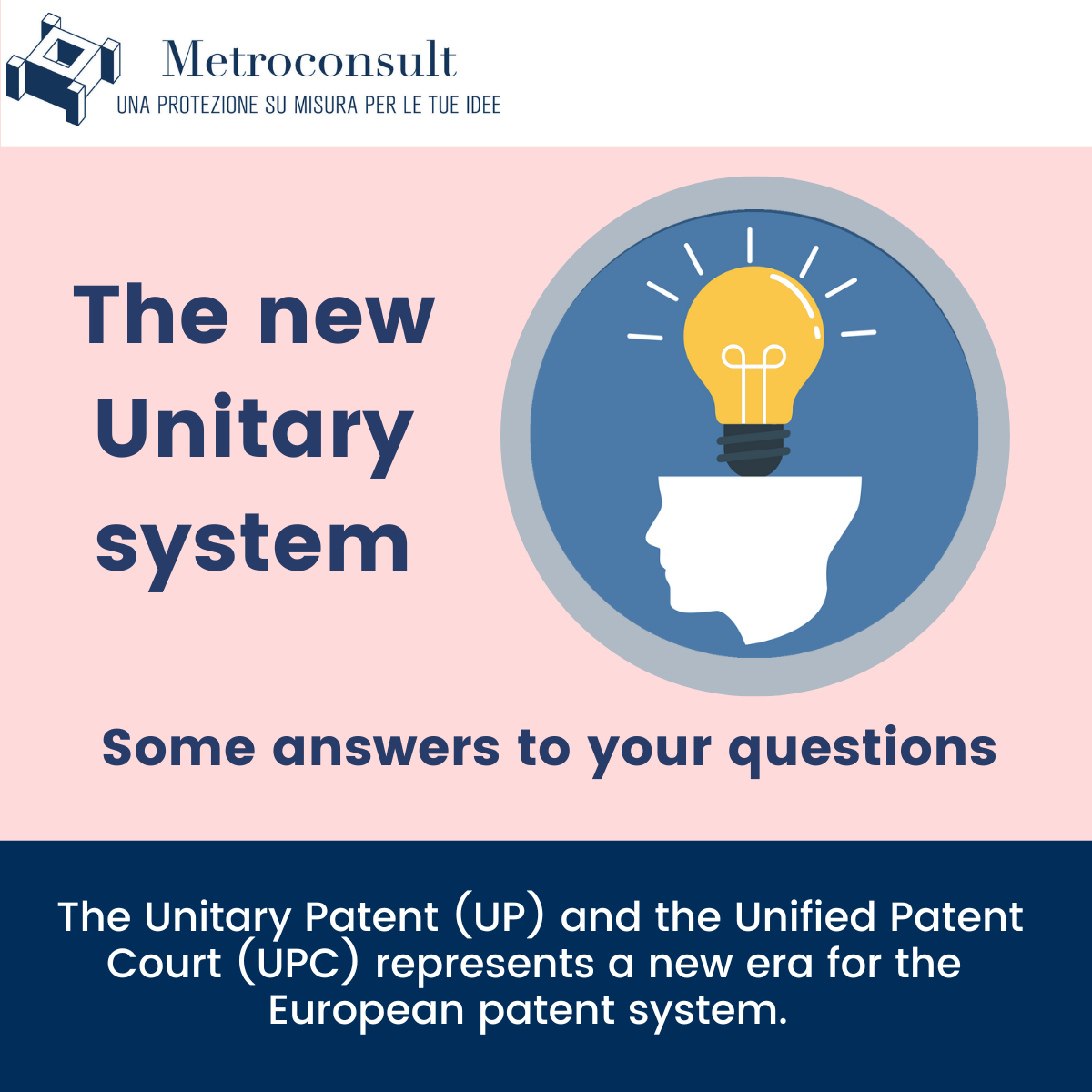The unitary patent package, including the Unitary Patent (UP) and the Unified Patent Court (UPC), entered into force on June 1st and represents a new era for the European patent system.
In accordance with the well-established procedure envisaged by the European Patent Convention (EPC), the new unitary patent system allows the owner of a granted European Patent (EP) to choose a single procedure to obtain a Unitary Patent valid in most of the countries of the European Union and subject to the jurisdiction of the new Unified Patent Court.
The aim of this article is to answer common questions on the new unitary patent package, leaving the more complex questions or peculiarities related to individual cases for a more in-depth debate with our IP consultants.
Which countries are affected by the new unitary patent system?
To answer this question, it is necessary to divide the countries belonging to the European Patent Convention into four broad categories:
- European Union countries that have signed and ratified the Unitary Patent Agreement;
- European Union countries that have signed, but not yet ratified the Unitary Patent Agreement;
- European Union countries that have not signed the Unitary Patent Agreement;
- Countries that do not belong to the European Union and are therefore excluded from the Agreement.
The system is still evolving. A reference date should therefore be set. As of today (June 2023), the new unitary system has been signed and ratified by Austria, Belgium, Bulgaria, Denmark, Estonia, Finland, France, Italy, Latvia, Lithuania, Luxembourg, Malta, Holland, Portugal, Slovenia, Sweden and Germany.
Other countries in the European Union, despite having signed the Agreement, have not yet ratified it; such ratification could take months, even years, as in I reland where constitutional changes are needed before ratifying the Agreement. Until such ratification, the new unitary patent system will not be applicable to these countries; still as of today, the European Union countries belonging to the EPC which, despite having signed the Agreement, have not yet ratified it are Cyprus, Czech Republic, Greece, Ireland, Romania, Slovakia and Hungary. For these countries, the new system will enter into force upon ratification.
reland where constitutional changes are needed before ratifying the Agreement. Until such ratification, the new unitary patent system will not be applicable to these countries; still as of today, the European Union countries belonging to the EPC which, despite having signed the Agreement, have not yet ratified it are Cyprus, Czech Republic, Greece, Ireland, Romania, Slovakia and Hungary. For these countries, the new system will enter into force upon ratification.
Furthermore, three EU countries – Croatia, Spain and Poland – have not signed the Agreement. For these countries, the “classic” EP validation process continues to apply.
Finally, there are countries such as Albania, Great Britain, Iceland, Liechtenstein, Monaco, Norway, North Macedonia, San Marino, Serbia, Switzerland and Turkey which, although part of the European Patent Convention, do not belong to the European Union and are therefore not subject to the Unitary Patent and to the jurisdiction of the Unified Patent Court. For these countries, as well as for countries that have not yet signed or ratified the Agreement, it continues to be possible to validate the European patent in individual countries according to the procedures already in place before the introduction of the unitary patent system.
Am I forced to follow the path of the new unitary patent system?
The answer is simple: no.
After the entry into force of the new unitary system, it is always possible to validate an European Patent in only the Member States of your choising.
If the answer to the question is simple, choosing between the two different options can be more complex. The decision must be built on an internal strategic assessment of your company, based on careful analysis of various factors such as, for example, the markets of interest, the costs to be incurred, if it is appropriate in case of dispute referring to a single European court (UPC) instead of individual national courts, or if, over the years, you want to apply logic of “prune” some of the various countries in the portfolio (which obviously is not possible with the Unitary Patent since it is a “Unitary” title).
What Opt-Out is?
If you opt for the Unitary Patent, that patent will be subject to the jurisdiction of the Unified Patent Court.
Conversely, if you don’t want to follow the unitary patent path, but prefer to validate the European Patent in each single countries of interest, there is still a decision to be made: whether or not to “Opt-Out”.
If you don’t Opt-Out, the European Patent applications and the European Patents granted and validated in the individual European countries will fall under the jurisdiction of both the national courts and UPC (dual jurisdiction) for the entire duration of the transitional period of (at least) 7 years from the entry into force of the Unified Patent Court.
“Opt-Out” preve nts patents validated in individual countries from automatically becoming subject to the jurisdiction of the UPC. In practice, opting-out removes European Patent applications or European Patents granted from the jurisdiction of the UPC. If you Opt-Out, the jurisdiction will therefore only be that of the individual countries of validation.
nts patents validated in individual countries from automatically becoming subject to the jurisdiction of the UPC. In practice, opting-out removes European Patent applications or European Patents granted from the jurisdiction of the UPC. If you Opt-Out, the jurisdiction will therefore only be that of the individual countries of validation.
In the case of patents owned by two or more holders, as happens for example for patents developed in a collaborative environment between businesses and universities, the Opt-Out choice must be made by all patent owners, who must agree on this decision.
It is possible at a later stage to revoke Opt-Out through a so-called Opt-In procedure, with special exceptions.
Is the Unitary Patent less expensive than national validations? How much does it cost?
To provide an exhaustive answer to this question, it is necessary to go into the details of each individual cases.
However, using the “rule of thumb” and considering the countries of greatest interest that are currently part of the UP Agreement, it can be assumed that the cost of the Unitary Patent is more and less equal to four national validations .
A preliminary answer can therefore be: “If I’m interested in validating the European Patent in more than four countries, the Unitary Patent could be the best option”.
Why is this a simplistic answer? A practical example can clarify.
By following the national validation process, a number of national patents are obtained, one for each country of validation; during its 20-year life, it often happens that a patent can lose relevance for the business, but still retain its corporate interest. In this case, the company can carry out a “pruning” process of the portfolio, keeping the patent only in the countries of greatest interest for the company business (for example Italy and Germany) and letting the other rights lapse. The costs of maintenance fees (which, as it is known, increase significantly over the years) will thus decrease.
Conversely, following the path of the Unitary Patent, there is a single and valid title in all the countries that have signed and ratified the UP Agreement. This title is of an “on/off” type, so it is necessary to bear the costs inherent its maintenance fees up to the end of 20 years (or as long as you want to keep the patent alive), without any possibility of “pruning”.
In conclusion, it is possible to provide a concrete answer that meets your business needs only by analyzing each individual case.
Our Consultants are at your complete disposal to provide further information on the Unitary Patent and the Unified Patent Court, and identify together the best protection strategy for your patent portfolio.
For more information, please write to: info@metroconsult.it.


